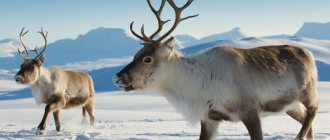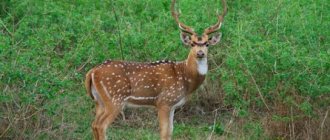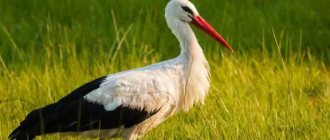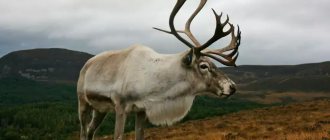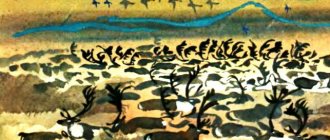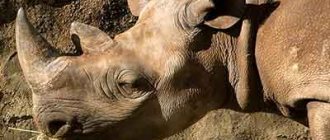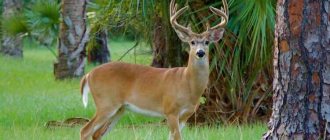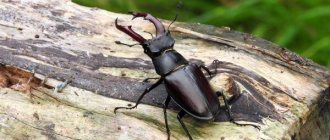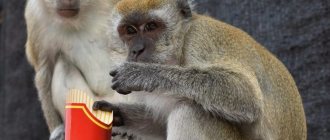Origin of the species and description
Photo: Sika deer
The flower deer (sika deer) has a special place in the deer family. This is due to the fact that it was on the verge of depopulation and is therefore listed in the Red Book. This is because the population of eastern countries, mainly China and Tibet, highly valued the healing capabilities of drugs based on non-ossified horns. Pantocrine was extracted from the antlers of sika deer, which had a beneficial effect on the central nervous system.
The cost of antlers was very high, which is why hunting for pantach deer increased, and their population rapidly fell. At this rate, at the beginning of the twentieth century in the USSR there were barely a thousand heads of sika deer, and in some areas of Asia this species completely disappeared. Based on research, paleozoologists have concluded that the ancestry of modern deer goes back to South Asia. It is believed that sika deer are of more ancient origin, this fact is confirmed by the presence of a simpler structure and shape of horns than those of red deer.
When and why do deer shed their antlers?
Sometimes in the forest you can see shed antlers of a deer (photo below). The process of getting rid of old growths can be compared to ordinary molting, which is inherent in many animals. The horns on the heads of these animals are a living organism. Its cells grow, divide and die. At a certain period in a deer's life, a ring forms at the base of the antlers, preventing the blood flow that supplied them with nutrients.
The process of deer shedding hard outgrowths begins with small fragments breaking off from them. The size of the next pieces that break off becomes larger and larger. And at some point the deer's antlers completely fall off. This occurs after the end of the mating season, which for representatives of the Cervidae family lasts from December to February. In the spring, deer grow new antlers. This process lasts two to four months.
To speed up the shedding of their horns, animals rub them against tree trunks, stumps, the ground, logs or large stones. The older the deer, the earlier it tries to get rid of the branchy outgrowths. After all, over the years it becomes increasingly difficult for old individuals to carry such a load on their heads.
Sometimes it happens that after this process a rather large fragment of an antler remains on the deer’s forehead. This can cause discomfort, because the animal’s head will tilt to one side and interfere with its freedom of movement. In such a situation, the male will try to get rid of the remaining element as quickly as possible, for example, by grinding it off on a stone.
Appearance and features
Photo: Sika deer Red Book
Sika deer are quite small in size compared to other relatives. It has a graceful and slender physique. The body of both individuals is short, the sacrum has a rounded shape. Incredibly mobile. Thanks to this, they can develop fast speed and reach a jump height of up to 2.5 meters and a length of up to 8 meters.
Only males have horns. The crown shape is relatively proportional with not much weight. The length and weight of the animal’s horns changes as it grows, and there can be from 65 to 80 cm on the horns there are no more than five processes, in rare cases there are six. The shoots are smooth to the touch, have a yellowish almost straw color, and brown closer to the base. The color of the animal's fur depends on the time of year. In summer, the fur has a pronounced red color, which turns into a lighter color as it descends towards the belly. There is relatively dark fur along the ridge, and the legs are pale red.
A characteristic feature is the presence of white spots that are distributed along the back. At the same time, in the summer, on the sides and hips their number is smaller and the outlines are not so rough. In addition, not all adult individuals have them, and as spring arrives they disappear altogether. With the onset of winter, the fur of males changes, acquiring a gray, sometimes dark brown color, and becomes light gray in females. The color of the mirror, which is located in the inner thighs, remains almost unchanged - white. Shedding in animals occurs in April and September.
The weight of a mature male varies between 115 - 140 kg, females 65 - 95 kg, the height at the withers can reach up to 115 cm, and the body length is 160 - 180 cm. The life expectancy of sika deer in the wild is up to 14 years, in captivity 18 - 20 years
Lifestyle
Sika deer are predominantly nocturnal. This animal is characterized by caution. A deer will only decide to leave a place protected by dense vegetation in search of food.
A herd of 15 heads requires a plot of land of at least 800 hectares. A male with a harem can live on 400 hectares, while a single animal needs 200 or even 100 hectares.
The maximum distance that deer can travel in a day is 2500 meters. The time of greatest activity occurs in the morning and evening hours; in winter, animals feed during the day.
The animals have good swimming skills; they can swim a distance of 10 km or more.
In the wild, a deer lives no more than 14 years.
Where does the sika deer live?
Photo: Ussuri sika deer
The native lands of the sika deer include countries such as China, Korea, North Vietnam and Taiwan. It is also adapted to stay in the Caucasus, Europe, the USA and New Zealand. But the most favorable environment for this type of animal was Japan and the Far East. Especially in Japan and Hokkaido Prefecture, their population has recovered due to the extermination of wolves and the number of hunters is minimal.
Each species has certain requirements for living conditions:
- Sika deer prefers broad-leaved oak forests rather than cedar-broadleaf forests, although it is sometimes found in the latter;
- Deer stay in the upper part of the forest and in the area of alpine meadows;
- Tugai deer (Bukhara) will choose bushes and dense thickets along the banks of rivers or lakes.
In the Far East, the animal can be found in Primorye. The southern parts of the Primorsky region have the most suitable terrain, this is due to the fact that snow does not lie for more than 8 - 10 days, and also due to the Manchurian-type forest with good undergrowth. Quite rarely they can be found in open areas, in which precipitation in the form of snow can exceed the mark of 600 - 800 mm. Since these weather conditions are very harsh and make movement much more difficult and make the animal more exhausted.
Starting from the 30s, attempts were made in the USSR to adapt deer, followed by restoration of the gene pool. To do this, they were brought to nature reserves (reindeer farms), the environment of which was favorable for their existence, namely:
- Sukhudzinsky Nature Reserve;
- Ilmensky Nature Reserve (located in the Urals);
- Kuibyshevsky Nature Reserve;
- Teberda Nature Reserve;
- Khopersky Reserve;
- Okscomsky Nature Reserve;
- Mordovian reserve.
In some cases this was successful, but there are also those where the hunt for the animal did not stop and reached a critical point, which led to almost complete extinction.
Red deer antlers
Red deer antlers begin to grow and develop towards mid-April. Already in May, the length of antlers (young outgrowths) is about 10 centimeters. Throughout the summer they continue their intensive growth and reach maturity in August. By the end of summer, the antlers are freed from the skin.
As for the age characteristics of deer antlers of this subspecies, fawns of the first year of life have “matches” or “hairpins” on their heads, the length of which reaches 15 centimeters. Over the next twelve months, 3 shoots appear on the horns of red deer. In the future, branches will be added one per year until the animal turns 7 years old.
Red deer shed their antlers every year. This occurs in March-April, less often in February. Often, before getting rid of old growths, males walk around trees and rub their heads against them. At the same time, the bark on the trunks is damaged, and specific marks appear that are left by deer antlers (photo can be seen below).
The process of shedding outgrowths is influenced by the age and physical condition of the red deer. New horns begin to grow 5-10 days after the old ones have fallen off.
What does the sika deer eat?
Photo: Animal sika deer
The deer's diet includes more than 390 varieties of plants, most of which consist of tree branches and shrubs. In the Primorsky Territory, tall grasses are in the foreground rather than tree and shrub food. In the summer, the main delicacy is: acorns, leaves, buds, young shoots and thin branches, shoots of linden, oak, and Manchurian aralia.
But Manchurian walnut, Amur grapes and velvet, lespedeza, acantopanax, elm, maples, ash, sedges, umbelliferous and other types of deciduous trees in summer are also preferred. On the eve of winter, the animal feeds on those types of plants that are able to satisfy nutritional needs during fattening.
Also, this diet sometimes occurs in the second half of winter:
- acorns, nuts, beech fruits;
- branches of hazel, oak, aspen, willow, chosen, bird cherry, alder, euonymus;
- shoots of young pines, elm, euonymus, brittle buckthorn;
- spruce bark
Deer are not averse to eating kelp and zoster algae, which contain the salt content necessary for animals. If there are feeders in the forest, deer are not averse to eating hay. In the process of searching for the necessary minerals, deer enter the area of warm mineral springs. There they can lick algae, ash and other waste from the sea that ended up on the shore. Animals that are adapted to southern terrain visit areas with artificial salt licks.
The territory in which deer are located depends on their number in the herd. If a single person has a plot of 200 hectares, then a male with a group of females will have up to 400 hectares. Larger herds cover an area of 800 - 900 hectares.
Moose antlers
The elk has huge, branched, spade-shaped antlers. Such outgrowths adorn the heads of only males. Moose antlers are impressive in size. After all, their weight is up to 20 kilograms, and their length can reach one and a half meters.
The antlers of young elk calves are soft. Their interior contains blood vessels, and their exterior contains delicate skin and soft fur. If a young individual injures its head growths, they bleed. In this case, the animal experiences pain. Later, the antlers of a young moose become harder and branches appear on them. But the outgrowths acquire the shape of a shovel only in the fifth year of life.
During August-September, elk go through mating season, after which the period of shedding their antlers begins. Animals get rid of old growths at the very beginning of the cold period. This makes life much easier for moose, because in winter it would be difficult for them to move with heavy antlers covered in snow.
Features of character and lifestyle
Photo: Sika deer in Russia
The sika deer is quite timid and very secretive. A meeting with this cautious animal in an open area, not counting dense thickets, is equivalent to zero. He can hear the approach of an unwanted guest or predator from a fairly long distance. Since he has acute hearing and a very developed sense of smell. As the season changes, the animal's behavior also changes.
In summer, deer are constantly on the move and actively feeding. In winter, energy levels drop noticeably, they become inactive, and more often remain lying down. Only when the wind moves strongly does it become necessary to seek shelter in a denser forest. Sika deer are fast and hardy. They are excellent swimmers; they can cover distances in the sea of up to 12 km.
The animal is prone to infectious diseases; cases of diseases have been recorded:
- rabies, necrobacteriosis, pasteurellosis, anthrax and tuberculosis;
- ringworm, candidiasis;
- dicroisliosis, helminths (flat, round and tape);
- ticks, midges, horseflies, lice eaters and others from the family of ectoparasites.
The last of the above cause discomfort and anxiety.
Classification
In nature, sika deer come in three subspecies:
- Japanese - common in continental Europe.
- Ussuri - lives in Russia and China.
- Hokkaido - about. Hokkaido.
There are also introduced subspecies. Among them is the European spotted deer, which is found in hunting grounds in the European part of Russia.
Social structure and reproduction
Photo: Sika deer calf
Deer reach puberty at 1 year and 6 months, but females often breed at three years. Males are ready to fertilize no earlier than four years of age. The mating season begins in September and ends in early November. The duration of which is 30 - 35 days. During this period, the roar of the male can be heard at distances of up to several hundred meters. Mating takes place over several days, this is due to the fact that the female may not be fertilized. The process occurs several times with a short period of time, on the leks specially knocked out by the male’s hooves.
The duration of pregnancy can be 215 - 225 days or (7.5 months). One calf is always born and in exceptional cases twins. Calving occurs in May, rarely in June. A newborn fawn can weigh from 4.5 to 7 kg. The mother's udder, the newly born calf begins to suckle almost immediately after emergence, and after a couple of hours takes its first steps. Calves can begin grazing 15 - 20 days after birth, and suck the udder until the next calving, if it is not separated from the mother.
Young offspring develop more intensively in the summer; with the arrival of winter, these processes slow down a little. Only after the second year of life are there characteristic differences; the female remains small in size, and the male acquires small tubercles at the base of the skull, which will eventually develop into horns.
Why do deer have antlers?
The large branched horns of these animals have several functions, one of which is protection from enemies. Deer don't often use their head growths to butt. However, deer antlers, which are impressive in size, have a terrifying effect on predators, and not every animal will risk attacking their owner.
Also, bony outgrowths on the forehead of representatives of the Cervidae family are often used as a device for obtaining certain food in the winter. For example, in order to enjoy their favorite reindeer moss, representatives of the northern subspecies dig up snow with their horns.
Another purpose of the growths on the head of a deer is to participate in fights that males arrange during the rutting period. It is in this situation that deer use their antlers to hurt their opponent. During the mating season, the animal attacks its rival and acts with particular cruelty. The defeated male bleeds, and the winner receives the right to mate with a young female as a trophy.
Natural enemies of sika deer
Photo: Wild spotted deer
Unfortunately, the sika deer has a large number of ill-wishers, including:
- wolves (sometimes raccoon dogs);
- tigers, leopards, snow leopard;
- brown bear (attacks relatively rarely);
- foxes, martens, wild cats (prey on the young generation).
Compared to other predators, gray wolves caused considerable damage to this species. Wolves hunt in packs, driving and surrounding a small herd. This mainly happens in winter and early spring, when the movement of sika deer becomes much more difficult. The weakness and lethargy of the animal, caused by the lack of the required amount of food, also affects it. Solitary animals often become prey for the cat family; they are specialized predators.
An unsuspecting deer could be ambushed. Since these cats are able to move even on loose snow, the victim has virtually no opportunity to escape. In snowy and cold winters, the animal may die from exhaustion because it is not able to obtain food for itself. It becomes weakened and painful, which attracts medium- and small-sized predators. The only way to protect yourself is to escape. We should not forget that the animals suffered a lot from the intervention of people who hunted young antlers to make medicine.
Antlers are the pride of deer
Deer antlers are an element that only males of the Cervidae family can boast of. But there are exceptions, when in some subspecies outgrowths are also present on the head of female individuals. These include, for example, reindeer.
Deer antlers are not hollow, like those of cows, but have a cellular structure. The age of the animal can be determined by the number of shoots on them. After all, the number of branches and the size of the horns themselves increase from year to year.
Adult representatives of the family Cervidae annually, after the end of the rut, that is, the mating season, shed their growths on the forehead. After this, the animal develops new horns. During their growth, they are covered with delicate and sensitive skin. It contains a large number of blood vessels that nourish the horny bone and help strengthen it.
Population and species status
Photo: Sika deer from the Red Book
In the Red Book, sika deer has category 2 status - “declining in numbers.” A strong drop in the population of an extremely fragile species is associated with living in unstable climatic conditions and prone to sudden changes. Announcements of constant hunting for the production of skins, meat and antlers.
There are also other important factors:
- exploration of a new area followed by deforestation;
- a large number of wolves, wild dogs and other predators;
- construction of new settlements near and on the territory where the animal lives;
- tendency to infectious diseases, hunger;
- failure to domesticate.
Attempts have been made to keep deer in parks and reserves. In some, animals received feed all year round without access to pastures. In others, they received additional food only in winter and grazed freely in the lands. But the slow restoration of trees and dense bushes affected the quality of food, which in turn sharply deteriorated. This became the main reason for deer leaving pastures.
When keeping deer in close relationship, without separation, it affected life expectancy. The susceptibility to disease increased, females became barren and unable to bear offspring in the future. Nevertheless, partial restoration of the species was achieved in the Primorsky Territory, thanks to a balanced system of use of natural resources, and partial protection of the animal.
How do fawns develop antlers?
In the first year of a fawn's life, two button-like protrusions grow on its forehead. They are called “legs” and are present on the animal’s head throughout its life. In the spring, antlers begin to grow from these “buttons,” which increase significantly in size during the summer. At first, straight shoots appear, which will later branch out.
The young horns of the fawn are covered with skin. Therefore, they visually appear soft and velvety. During the fall, this skin dies off, revealing bare bone. The antlers of a young deer become similar to those that adorn the heads of adult deer. However, these outgrowths are distinguished by a significantly smaller size and number of processes.
Why are deer's antlers cut off?
In reindeer herding farms, antlers are cut from the heads of live reindeer. These are young deer antlers that have not yet had time to ossify. Frontal antlers are obtained from the heads of slaughtered animals, which must be cut off with a fragment of the skull.
From the young horns obtained, pantocrine is made - a medical drug that affects the nervous system and is used to treat various diseases.
Ripe antlers are characterized by the presence of divided branches that have swollen, drop-shaped ends. The surface of the processes should not be ribbed. Antlers of the required ripeness are highly valued. If young deer antlers have not grown enough, their healing properties are not fully revealed. The same applies to overripe antlers, which have already acquired a ribbed structure and pointed ends.
After the young horns are cut, they are sent fresh for processing or canned for later use.

